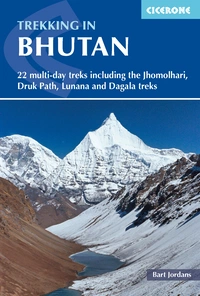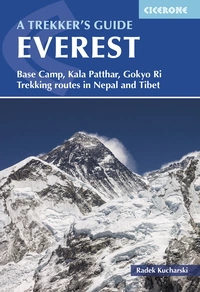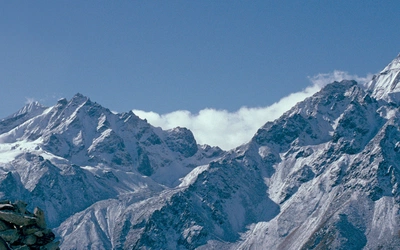Ladakh: beyond the Khardung La
The long-forbidden lands north of the Khardung La were beyond the wildest dreams of Sian Pritchard-Jones and Bob Gibbons when they first met in 1983 in Leh, Ladakh. Now easily accessible, this area, nestling in the shadow of the Himalaya and the Karakoram, hides many startling secrets and is dotted with magical monasteries that reveal a fascinating culture.
The vast high-altitude region of Ladakh in northern India is a fairytale land of glaciated mountains, mysterious gorges, barren deserts and pristine lakes. Geographically part of the western region of the Tibetan plateau, Ladakh is a wild domain, where trekkers, travellers and explorers can discover a unique destination. For centuries it was isolated from the world – only the deep-throated sound of long horns and the evocative chants of monks lost in meditative prayer pierced the silence. The Buddhist religion has long since been regenerated and cast into a unique form that survives only across the greater Himalaya.
Strange and often forbidding looking deities grace the monasteries that cling to the cliffs and canyons.
During the late 19th century, Ladakh and the Karakoram region were the focus of the Great Game, as Russia, Britain and China vied for military influence across Asia. When the dust settled, all three empires were kept apart by nature, with winter storms and the highest peaks reigning supreme. Isolated, the hardy people toiled in the spartan fields during the short but life-giving summers and hibernated through the long, bitter winters.
When Ladakh first opened to tourists in 1977, the only access was by a rollercoaster road over the Himalaya from Srinagar in Kashmir, laced with hair-raising voids and freezing high-altitude passes. As political tensions erupted in Kashmir in the mid-1980s, a new road opened from Manali (in Himachal Pradesh, north of Delhi) to Ladakh. Today, visitors can also take a wonderful flight across the endless mountains to Leh, the capital of Ladakh. The landing is sensational, as the plane descends along the Indus river, almost clipping the hill of Spituk monastery before gliding uphill into the valley. Since the airport opened, more visitors have discovered the myriad monasteries, pristine trekking trails and colourful festivals of this region.
Within Ladakh the valleys of the Nubra and Shyok rivers, beyond the Khardung La pass, were the last frontier opened to travellers, being adjacent to the Line of Control between India and Pakistan. Now a steady stream of jeeps and buses cross the pass each day of the summer season, to see some of the strangest sights on earth.
Leh
It pays to spend a few days in Leh before commencing any journey, as the altitude is significant. Leh sits at around 3500m, so everyone needs time to adjust to the thin air. In fact, Leh has enough sights to while away a week. The palace, similar to the Potala Palace in Lhasa, dominates the town, a great mud-built, nine-storey edifice surrounded by monastic quarters, dingy low alleyways and quaint mud-walled houses. Above is Tsemo monastery and the Dard fort, with an amazing panorama reached by an exciting trail or a gentle but long road. Close by are Shanti Stupa, Shankar monastery and several colourful bazaars. The main street hosts some pleasant rooftop cafés. Leh has many guesthouses and a good number of palatial hotels, all built in traditional Tibetan style.
Khardung La (17,982ft)
From Leh the route heads north on a well-engineered road that snakes up endless hairpins to gain the serrated ridgeline of the Ladakh Range and the notch of the Khardung La pass. A sign at the summit of the pass, said to be at 17,982ft, welcomes you to ‘one of the highest motorable all weather roads in the world’. Although the exact altitude is questionable, it is without doubt one of the highest road passes on the planet.
On its busiest days, the icy pass is also briefly ‘the highest traffic jam’ in the world.
Excited Indian domestic travellers take selfies; others try to get a photo of the Karakoram ridges ahead. A café serves steamy masala tea and Indian motorcyclists kickstart their sturdy Royal Enfields for the descent. Perhaps it’s not what we foreign visitors expect, but progress comes in strange ways to ‘Incredible India’.
The chilly wind gives way to peaceful canyons as the road drops to the Shyok river, a gleaming silvery ribbon of water in an endless barren landscape. The upper Shyok river is fed by the glaciers and snowy spires of the virtually unknown Rimo peaks, part of the Karakoram. We head west above the wide river floor, steadily losing altitude. The peaks are lost to view, replaced by isolated oases of lush greenery where streams drop thousands of feet to the valley floor, providing life-sustaining nectar for habitation. Thankfully our young driver, Kalzang, is a master of the curves and the jeep makes the rough road feel smooth (not quite!).
Diskit monastery
Our destination for the first day is Diskit monastery, perhaps one of the most impressive of all the Buddhist sanctuaries in the Shyok valley. Diskit village has a number of traditional-styled guesthouses with surprisingly comfortable amenities. The food on offer is tasty and quite varied – a mix of Indian, Tibetan and Western. Despite the five-hour rough ride, we drop our bags, grab our cameras and head up the rugged hill that is home to the exotic-looking, wildly located monastery. High above, forbidding cliffs and ridges soar to a deep blue sky – a hallmark of the Ladakhi landscapes.
The trail to the monastery zigzags up a stony hillside between picture-postcard chortens. Towering above, the monastery yields its treasures slowly to visitors. Small monastic rooms guard the main courtyards, still higher. Diskit belongs to the Gelugpa sect; its main dukhang (chapel) hosts some amazing images. One of the most sinister chambers is the gonkhang. This houses the protecting deities, strange and monstrous images, some with many heads and arms. Most have gruesome expressions, like Mahakala – the great evil one; Yamantaka, who guards the gates of heaven; Palden Lhamo – a fearsome female goddess, often riding a horse; plus lesser but no less frightening figures. These deities protect the people from bad karma, bad thoughts and personal demons.
Hunder
The next day we head to Hunder. Most Indian groups stay here overnight, close to the dunes where Bactrian camels take them for a ride. At this point it’s not clear who is taking whom for a ride! The camels are frisky and an oddity, having been stranded here when the Chinese closed the trade route to Kashgar after 1950. We decide a short trek to Hunder monastery, high above the shenanigans, is a more peaceful option. We have it to ourselves; a small but fascinating place of pilgrimage.
Turtuk
The road along the Shyok twists in and out of side canyons with ever more sheer cliffs and strange outcrops. Our destination is Turtuk, the last settlement before the Line of Control with Pakistan. Around the last sweeping bend of the river a sign informs us that ‘You are under enemy observation’. Unlike the rest of the valley, Turtuk is a Muslim village. It’s more like those in Pakistan on the Karakoram Highway that passes the peak of Nanga Parbat to the fabled valley of Hunza. Beyond this the Khunjerab Pass leads to the Chinese region of Xinjiang.
On our return a fiery sunset sets the barren mountain slopes aflame in a dazzling array of yellow, orange and red; it’s a magical moment.
Nubra Valley
Next, we head north into the Nubra Valley, famed for its more mellow climate, where fruits can be cultivated. The Nubra river drains from the Siachen glacier below the Karakoram. Along the valley is the refurbished Samstenling monastery, with magnificent Tibetan deities at which to marvel. We stay in a cosy guesthouse just north of the hot springs spa of Panamik.
Ensa Gompa
Across the wide Nubra river is one of the oldest monasteries of this region. Once reached only by crossing the raging torrents of the river and a dangerous rickety path, Ensa monastery is now accessed by a dubious bridge and a narrow rickety road that keeps the driver on his toes. The newer part of the monastery is closed; the historic part is a sad but stunning place with crumbling walls and fading images. Haunting cliffs soar above. Across the plateau are scattered hundreds of chortens in all sizes. This ‘forest’ of chortens guards the Ensa ‘kora’, a pilgrimage trail around the monastic area. It’s a wild walk with fabulous panoramic views over the Nubra river, across to Saser Kangri (7150m, a sentinel peak of the lower Karakoram) and up the valley towards the hidden and off-limits Siachen glacier.
Back at the hotel we and a lone Australian are the only guests. The hordes are already en route to our next destination – the famed Pangong Lake that straddles the ill-defined and much-disputed ‘Tibetan’ border of India with China. We sleep surprisingly well and the food is good.
Shyok Valley and Tangtse
The route to Pangong Lake follows the Shyok valley east; only those with a private vehicle can take this road so close to the Line of Control. The rugged valley is enchanting as we climb higher to Shyok village, with a superb view of the big bend that turns north to Rimo. A narrow defile leads up over a small pass to Durbuk and Tangtse beyond, our night’s objective. Tangtse is a spellbinding spot, with scenic cliffs and a mysterious canyon almost hiding the monastery. Much of it has been rebuilt; the Buddhist imagery is flamboyant. The hotel is superb, with welcoming staff and another soft bed. In Ladakh the old days of hard beds and cockroaches seem almost consigned to history.
Pangong Lake
Soon after leaving Tangtse the road hugs strange stony cliffs of conglomerate and sand, hemmed in by snowy peaks. Along a grassy stretch, cheeky marmots laze in the sun. The road climbs a small pass and suddenly the placid waters of the lake appear. Pangong Lake is a truly breathtaking sight. It takes on many forms; often calm and inviting, sometimes disturbingly rough and windy. When storm clouds gather, it is ghostly and intimidating. Along the shore Indian tourists are amazed by the scenery; so much of India is flat and green. Most are staying in the temporary summer camps at Spangmik. We manage to find a ‘proper’ guesthouse whose walls do not flap in the dusty wind; halfway up the hillside, it’s a fabulous place with inspirational views. The snowy peaks of the Ladakh Range dominate the western shore. Across the lake, the hills are more rolling, a harbinger of the daunting Tibetan plateau. To the south lies that part of the lake claimed and held by China since 1962.
We visit a small monastery above Spangmik, take a brief trek along the rocky hillside to a spring where blue sheep graze and drive to the village of Maan. The settlement and monastery are built in the traditional Ladakhi–Tibetan style. The lake takes on yet another hue as the sun dips below the mountains and a cold chill descends.
Chang La (17,688ft)
Our return to Leh is via the Chang La, an equally impressive drive. Way below the pass is the monastery of Traktok, hosting the most revered of icons, Guru Rinpoche, an historic figure of Tibetan Buddhism from the 8th century. His images grace monasteries across Ladakh, Tibet, Nepal and Bhutan. Below is Chemrey monastery, another fabulous sight erupting from a hilltop in a crescendo of white walls, red and yellow bands and guarded by dozens of chortens.
Thikse monastery
Shortly before our return to Leh, along the Indus valley is the famed Thikse monastery, along with others including Hemis, Matho, Stakna and Shey.
The circuit of the Khardung La and the Chang La is indeed an adventurous journey to savour, a wild memory to cherish.
For those seeking tranquillity and adventure, there are dozens of trekking routes across Ladakh and Zanskar to suit all levels. Popular routes are the Markha Valley, Lamayuru to Rangdum, and across the Zanskar range to Phuktal and Manali. These routes and many others are documented in the Cicerone guidebook Trekking in Ladakh by Radek Kucharski.
For more on the cultural sights, monasteries and background, see Ladakh: A Land of Mystical Monasteries by these scribes, published by Amazon/Kindle/Expedition World.
Getting there
Flights from Delhi to Leh with Jet Airways, Air India, Go India, Spicejet and Vistara. A few flights from Mumbai. Road access via Manali (Rohtang Pass) and Srinagar.
Tours
Minimum three days but five days is much better. Tours can be arranged through most hotels in Leh. Inner Line Permits must be arranged through a tour operator or hotel. Independent travel is possible to many areas, but not all.
Season
Mainly June to October but check weather conditions if planning to travel by road. Off-season is also OK in Leh and along the Indus valley.
Trekking in Ladakh
Eight adventurous trekking routes
£22.95
An essential guidebook to trekking in Ladakh. With detailed descriptions of eight treks in the Ladakh, Zanskar and the Markha Valley of north India, including details on combinations and alternative routes. Ladakh is a remote environment where trekking is extremely challenging, for adventurous trekkers only. Practical information is also included.
More information













